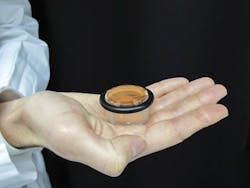Optofluidic sensor irradiated with light measures blood sugar noninvasively
The Swiss Federal Laboratories for Materials Science and Technology (Empa; Dübendorf, Switzerland) and the University Hospital Zurich in Switzerland have developed an optofluidic sensor that, when irradiated with light, can measure glucose (blood sugar) level through the skin without drawing blood.
Dubbed Glucolight, the sensor comprises a microdialysis measuring head developed at University Hospital Zurich, a "smart" membrane developed at Empa, light sources, a pump, and a microfluidic chip with a fluorometer that was also developed at University Hospital Zurich.
The smart membrane contains special dye molecules known as spiropyrans. If ultraviolet (UV) light is beamed onto the spiropyrans, they alter their chemical structure and become charged (polar). When irradiated with visible light, they revert to their original, neutral structure. As a result, the membrane "opens" if irradiated with UV light and glucose molecules diffuse relatively easily through the membrane from the skin. If irradiated with visible light, considerably fewer glucose molecules pass through the membrane.
The measurement involves sticking the measuring head, which is around 3 mm in size, to the skin and irradiating it with visible light; some glucose molecules diffuse through the membrane from the skin. On the other side of the membrane, the glucose is mixed with a fluid and pumped through the microfluidic chip, while enzymes are added to trigger a reaction. During the reaction, fluorescence appears that is then measured by the fluorometer, and the computer uses the reading to calculate the glucose concentration. The process is then repeated with UV light. The computer then uses these two different readings to calculate blood sugar level.
The researchers filed a patent application for Glucolight in mid-2014 and the first clinical studies are scheduled at the University Hospital Zurich in 2015. However, it could be years before the use of Glucolight becomes standard. Empa and the University Hospital Zurich are currently in negotiations with partners for production and commercialization.
For more information, please visit www.empa.ch.
-----
Follow us on Twitter, 'like' us on Facebook, connect with us on Google+, and join our group on LinkedIn
Subscribe now to BioOptics World magazine; it's free!

